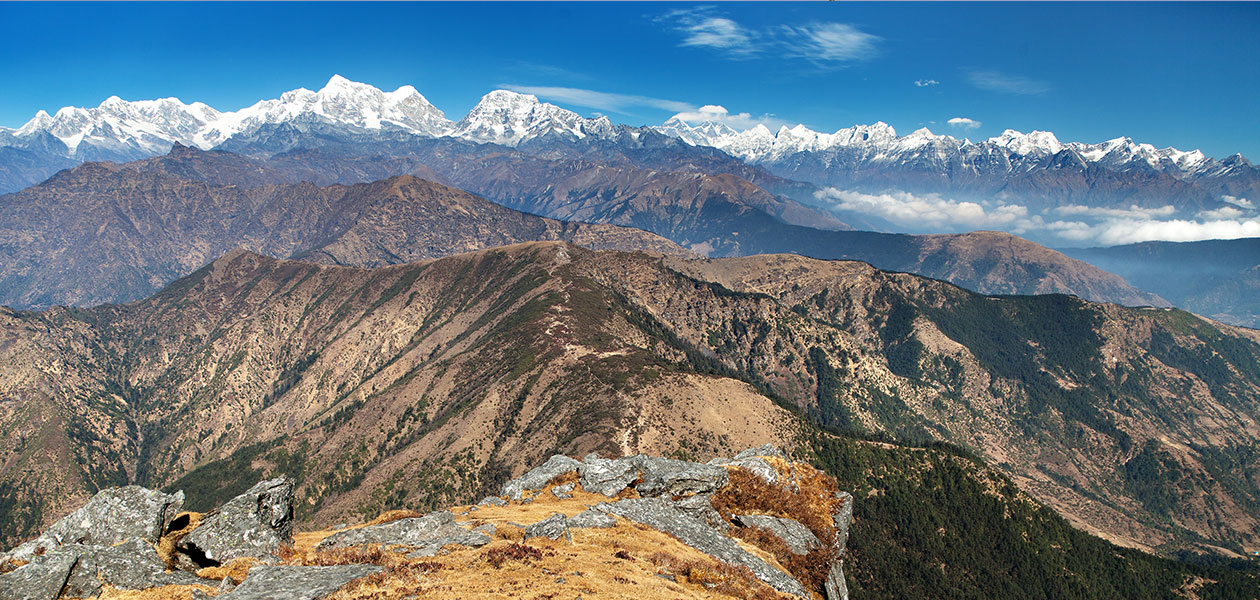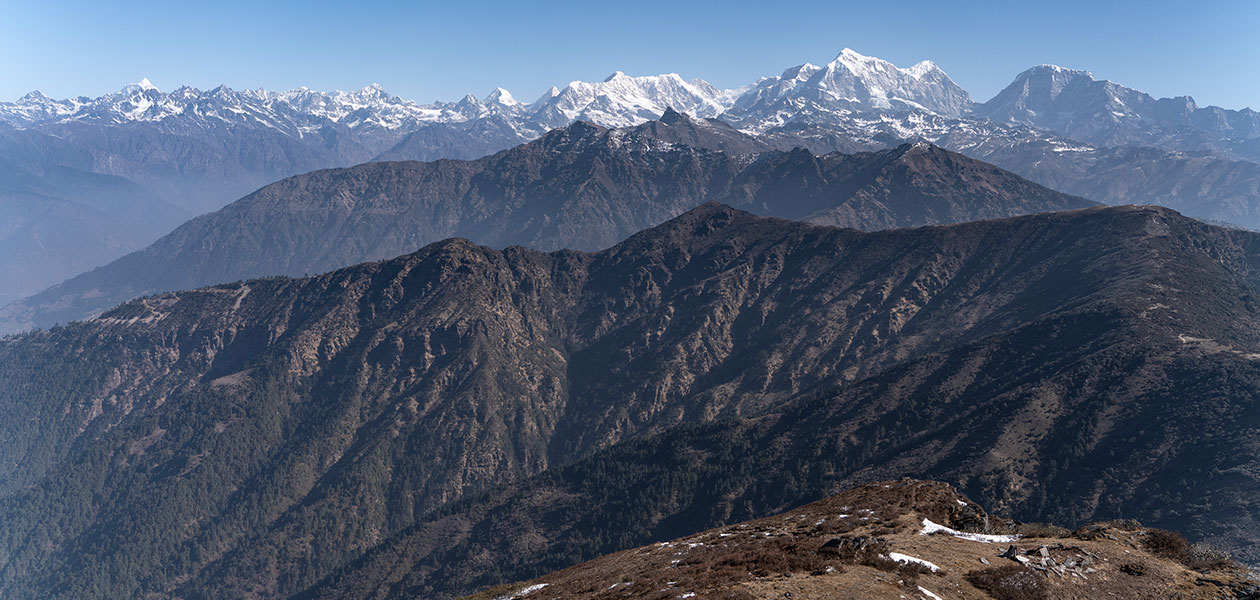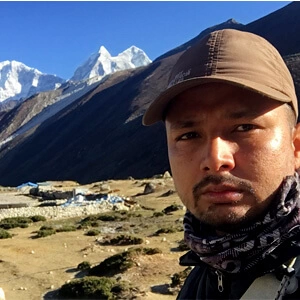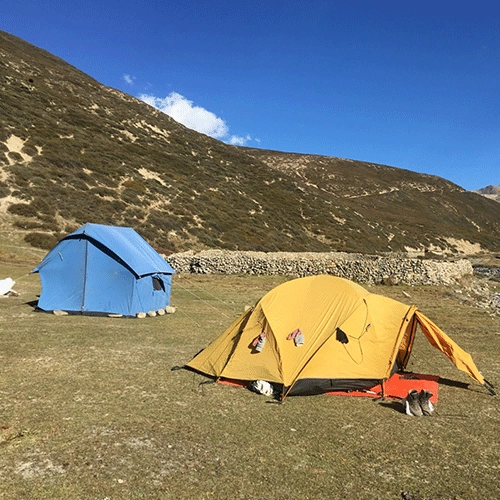Pikey Peak Trek Difficulty Breakdown
Although this trekking adventure is considered a moderately difficult Himalayan odyssey, there are several factors about this exhilarating journey that you have to be on the lookout for. Don’t worry. The difficulty factors of this exciting adventure are on a milder scale, so with appropriate measures, you will be able to overcome them easily.
Altitude Gain
Altitude gain is one of the most cornering factors in any kind of high-altitude journey; the same is the case for the Pikey Peak Trek difficulty. The overall altitude gain is not an issue here, however, Acute Mountain Sickness (AMS) that tags along with altitude gain is. After ascending from an altitude of 2,500 meters to 3,000 meters, the human body starts to show the symptoms related to altitude sickness, and if not dealt with properly, it can develop into an adverse stage that can often even if life-threatening.
However, in your Pikey Peak Trek, you don’t have to spend a significant time in the alpine and trans-Himalayan zone, so you don’t need to worry about the advanced stages of altitude sickness. During this exhilarating Himalayan journey, you begin your trek after driving from Kathmandu (1,400 meters) to Dhap Bazaar (2,850 meters). The maximum elevation you will reach on this trip is 4,065 meters (13,336 feet) at the summit of Pikey Peak.
Overall Trekking Distance
The overall trekking distance of Pikey Peak Trek is approximately around 60 to 80 km (37 to 49 miles). You will have to walk about 5 to 6 hours on average in this two-way trekking journey during the trekking segments. Although the distance covered during every day of the trek is not that great, and you will enjoy a slow-paced exploration, the long hours of the trek can be energy-draining for the trekkers who are not prepared.
You will have to traverse across the rugged landscapes of the lower Everest region and move along a gradually inclining trekking route. The steep sections along the route, where you have to frequently descend and ascend, are demanding challenges in the Himalayan trekking adventures in Nepal. Gradually climbing to a high altitude where the oxygen level is lower is more demanding than you might have imagined, even simple physical activities seem really draining and exhausting at a higher altitude than the lower sea level.
Unpredictable Climate
If you have ever done a high-altitude Himalayan trek in Nepal, then you understand how unpredictable the Himalayan climate can be. The Himalayan region is known to have its own climatic zone, and it doesn’t take much time for the climatic conditions to change drastically and move in a different direction. Although the climate is more predictable during the high seasons (autumn and spring), it can be an unknown force during the off-seasons like monsoon and winter.
Thus, this is one of the significant factors of the Pikey Peak Trek difficulty that you have to be on the lookout for. This exciting Himalayan journey will take you across several climatic zones like tropical, sub-tropical, temperate, and sub-alpine and reach the maximum point at the alpine zone. So, the climatic conditions and temperatures vary depending on the region; you have to consider the diverse climatic zones factor of this trek to make an adequate preparation.
Remoteness
It is not a new story that the Himalayan region in Nepal is one of the most underdeveloped and remote parts of the country. Even if the Everest Base Camp trek in the mainstream trek route takes you across a reasonably developed section of the trail, Pikey Peak Trek is a newly opened trekking route in the region that is yet to establish itself as a major trekking destination. So, even if the services and amenities available along the trekking route are on a moderate scale, you shouldn’t expect it to be too grandeur like a hotspot vacation destination.
The available facilities in the Himalayan trekking route are a limited number, and as you ascend to higher altitudes, there are even lesser number of services. Similarly, the health facilities, internet facilities, showers, charging, entertainment options, etc, are in limited numbers at the higher altitudes.
Acclimatization Process
The number of acclimatization is one of the major components of your Himalayan adventure that will determine your overall Pikey Peak Trek difficulty. The trekking pace followed by you and the rest period you will get along the trekking route will also decide your comfort level and your enjoyability scale. In general, it is recommended that you don't rush yourself to climb over 500 meters (1,640 feet) in a single day and take enough rest after climbing over the altitude of 1,000 meters (3,280 feet).
It is an important aspect of any high-altitude journey; if you climb too fast on the ascending route without giving your body enough time to acclimate to a new altitude, you will be at risk of altitude sickness. Not only that, if you don’t rest properly on a long journey, it will also increase the risk of other health-related issues, and falling sick during your remote high-altitude exploration is not a spot that you want yourself to be in.
Tips to Minimize Pikey Peak Trek Difficulty

After understanding the overall hurdles of the Pikey Peak Trek difficulty, you will be able to prepare for this exciting Himalayan journey more effectively. Here are some of our tips that you can follow to overcome the milder challenges and maximize the experience of this exciting exploration of the lower Everest region.
Physical Preparation
Physical preparation will help you overcome the majority part of the Pikey Peak Trek difficulty. How much effort you will put into your physical training will also determine your overall comfort level during this trip. You don’t have to aspire to be in top shape for this exploration, but you should have at least enough endurance, strength, and stamina level to meet the physical demands of the trek. If your strength and stamina level are at an optimum level, you will be able to easily complete the day-to-day trekking distance.
The general training recommendation for Himalayan treks in Nepal is about 3 to 6 weeks, but you can adjust the period according to your preference and how well you can fit the training schedule into your daily routine.
Strength and Endurance Exercises
- Squat
- Lunge
- Curl
- Plank
- Push Up
- Glute Bridge
- Plank
- Weightlift
- Pull Up
- Overhead Press
- Calf Raise
- Woodchop
- Face Pull
- Front Raise
- Leg press
- Step Up
Stamina Exercises
- Jogging
- Swimming
- Dancing
- Cycling
- Mountain Climber
- Jumping Rope
- High Knees
- Burpee
- Aerobics
- Kick Boxing
Mental Preparation
While the physical preparation is one the most essential factor to overcome the Pikey Peak Trek difficulty, you also shouldn’t completely ignore the mental preparation part. Your mental state and determination are huge factors that influence the overall success rate of any demanding journey. You should be ready mentally as well to take on this remote Himalayan odyssey; here are some helpful tips to assist you with your mental preparation front:
- Always stay positive and look at the bright side
- Don’t set high expectations for this remote journey
- Practice leaving your comfort zone
- Be flexible if you can adjust, try to adjust
- Surround yourself with positive people with a ‘can do’ attitude
- Try visualizing your journey
- Practice focused breathing and meditation
Do Pikey Peak Trek in High Season

If you decide to do this exciting Himalayan trek during the high seasons like spring (March, April, and May) and autumn (Septemeber, October, and November), the favorable climatic conditions will make your trip much easier. The off-season winter (December, January, and February) is the coldest season in the Himalayas and has freezing temperatures. Similarly, the trekking trails are covered with snow, and you will need to carry additional layers and equipment to keep yourself warm.
Although the atmosphere is refreshing in the monsoon (June, July, and August), the continuous rainfall adds challenges to the rugged Himalayan trails. Similarly, bad weather conditions severely affect itinerary plans and transportation modes. So, if you are a trekking beginner, it will be best if you stick to the peak seasons for pikey peak trek like spring and autumn.
Even amidst the high seasons, the autumn season has been dubbed as the number one season to trek in Nepal. This season has the most stable weather conditions, which means the trails are dry, and walking on them is far more comfortable than in other seasons. Similarly, the days are also generally clear, and the views of the pristine peaks are magnificent from anywhere on the trail. The autumn season is also known for its incredible cultural experience, as some of the biggest festivals in the country fall in this season (Dashain, Tihar, Chhath, Mani Rimdu, Indra Jatra).
The spring season allures the trekkers with its enchanting natural allurements. During the spring season, the entire landscape of the country is covered with lush greenery; you will walk through the captivating that is filled with the aroma of the bright wildflowers. If you are a nature lover and want to take time to explore the rare flora and fauna of the Sagarmatha National Park, the experience is unparalleled in this nature’s peak season.
Select an Ideal Package
When surfing for the trekking packages, don’t just go for the cost aspects, check out the overall itinerary plans and the includes/excludes section of the package. Even if the face value seems low compared to other available packages, they may have hidden costs and you may end up paying more than any other standard packages. However, while checking out the trek packages, your main focus should be on the length of the trek and the number of acclimatization days.
In general, the short-duration treks involve quick-paced walking and may not have enough acclimatization period. Naturally, if the trek is quickly packed, it means you will have to cover a longer distance during a single day, and it can be physically demanding. So, the longer duration trekking packages with enough acclimatization period will be far more comfortable and easier, like our standard 10 Days Pikey Peak Trek.
Eat Right and Stay Hydrated
You need to take care of your diet and hydration when you are on a long-haul journey, especially those where you have to traverse across remote regions. Eating a balanced diet will help you to keep your energy level at optimum. You will need enough fuel to trek for long hours each day if you don’t eat a balanced meal managing nutrient intake, then it can be hard to meet the physical demands of the trail and enjoy the experience at the same time.
Lack of a balanced diet also affects your immune system, and just going just for the taste eventually will create health related issues. Falling sick on the remote trekking route with limited health facilities is not a pleasant situation, the drop in your immune capabilities will also put you at the risk of altitude sickness. Similarly, hydration is another important aspect of the high-altitude journey.
If you drink the recommended limit of fluid during each day of the trek (3 to 4 liters), it will help you ti mitigate the risk of altitude sickness. You will also lose a significant water level from your body during long hours of trekking, so if you drink the recommended limit, you will be able to move around more comfortably as well.
Pack Right for Trek
Although you will not push for significant altitude like during the trekking adventures in the upper Everest region, you will still cross the alpine zone (above 4,000 meters) at Pikey Peak Summit in this lower Everest region exploration. So, you will still need to pack suitable layers and gear to traverse across different climatic zones. As your trekking trails will take you across the remote region of the Himalayas, you may also not find your preferred hygiene products and snacks.
You should focus on packing efficiently without missing out on the most essentials in your trekking route. If you don’t want to carry all your luggage by yourself, you can also hire a porter which will cost you about US$ 180. The porter will carry the luggage with a maximum weight limit of around 30 kg.
Packing Suggestions for Pikey Peak Trek
For Head and Upper-Body
- Sun blocking hat
- Lightweight beanie and warm insulated hat
- Head scarf, neck gaiter, or cowl
- Light moisture-wicking t-shirt
- Cotton shirt
- Thermals vest
- Warm sweater
- Breathable fleece jacket
- Waterproof/windproof hooded jacket
- Insulate warm jacket
- Down jacket
- Light and insulated pair of gloves
- Several pairs of undergarments (different layers)
For Lower-Body and Feet
- Comfortable hiking shorts
- Flexible cotton pant
- Waterproof/windproof trousers
- Warm insulated or woolen trousers
- Comfy trekking boot
- Sports or trainer shoes
- Socks (lightweight, warm and insulated)
- Waterproof gaiter
- Sandals or slippers for teahouses
Personal Hygiene
- Toothpaste, toothbrush
- Dental floss
- Facewash
- Bard soap and shampoo
- Sunblock cream
- Lip care and body moisturizer
- Shaving cream and razor
- Small mirror
- Nail clipper and hair comb
- Travel towel
- Tissu paper and wet wipes
- Toilet paper
- Cologne or body spray
- Hand wash or sanitizer
- Bug-repellent spray or cream
- Water purifier
- Enough personal medications (if any)
- Feminine hygiene products
Trekking Gear
- Sun protection glass (UV protection)
- Trekking poles
- Ankle support
- Sleeping bag or pad
- Backpack and duffle bag
- Color-coded packing sack
- Wastage bag
- Headlamp (don’t forget to bring an extra pair of batteries)
- Power bank
- Universal charging adapter
- Binoculars and camera
- Guidebook and map
- GPS device
- Water bottle
- Thermos flask
- Rain covers
- Books and magazines
- Entertainment options (card game, board game, PSP, etc)
Note: You are recommended to bring enough acceptable currency or local currency for personal expenses like charging, internet usage, drinking water, hot shower, etc. You should also consider buying snacks and energy bars in city areas; you may not find your favorites at the teahouse, and they are expensive at higher altitudes.
Gain Insights On:
Is Pikey Peak Trek Right for Me?

Pikey Peak Trek is one of the most exciting and relatively easier trekking adventures in the Everest region compared to other high-altitude explorations within the region. This lower Everest region trekking prospect offers an unforgettable experience across the authentic Sherpa settlements and charming natural allurements of the mainstream region. If you are wondering whether this adventure option might be the ideal deal for you or not, then you are worried about nothing. This newly introduced trekking route in the lower Everest region has it all that makes it an exciting Himalayan adventure, and the best thing about this exciting exploration is its mild difficulty level.
Anyone who doesn’t mind putting some effort into physical training can easily do this trek. Even if you are completely a beginner to high altitude Himalayan treks, this is the most exciting way to begin your endeavors in the Himalayas. Pikey Peak Trek is also a short trekking prospect in the Himalayas with a standard duration of 5 to 7 days, so if you want to take part in a thrilling Himalayan journey with limited time on hand, this is the next best alternative for exploring the Everest region.
There are also no age restrictions on this trek if you are curious about age requirements to take part in this Himalayan adventure. Due to its low elevation points and comfortable trekking route, hardly anyone fails to complete this exciting trekking journey. So, if you are reasonably fit and have good health, you are all good to explore this culturally and naturally enthralling trekking route of the lower Everest region.
Some Additional Helpful Tips to Overcome Pikey Peak Trek Difficulty
- Don’t rush with your journey, take short breaks along the route, being mindful of the overall itinerary plan
- When switching to higher altitudes, don’t climb too fast
- Energy drinks, bars, and electrolytes are quite helpful during the days when you are running low on energy
- Acclimatize properly and bring the altitude sickness medications just in case
- Avoid alcohol and cigarettes during your trek if possible
- Be mindful of the symptoms related to altitude sickness
- Follow every instructions and adhere to suggestions of the guides and porters
- If you are facing and complication, communicate with your trek leader immediately
- Stay focussed and determined, keep yourself positive consistently







